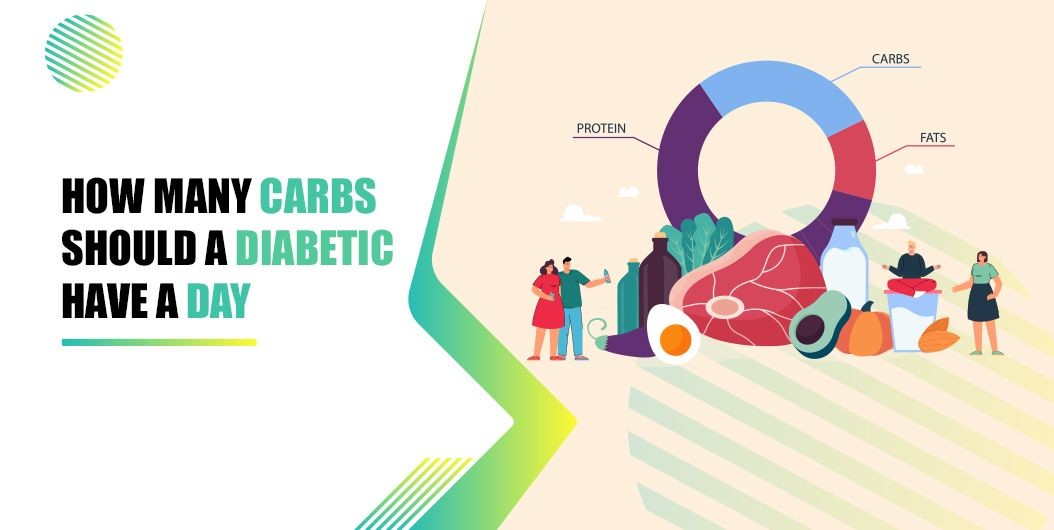
How Many Carbs Should a Diabetic Have in a Day?
Diabetes is a metabolic illness that affects blood sugar levels. As a diabetic person, try to get half of your daily calories from carbs.
Counting how many carbohydrates you consume daily is essential for diabetes management. It helps control blood sugar and understand the sugar and starch content in food. This helps plan the best way to eat for steady blood sugar levels throughout the day. Read more to learn about diabetes and carbohydrates.
For a diabetic person, aim to get half of your daily calories from carbs. If you consume 1,800 calories daily, aim for 900 calories in carbs, which is approximately 200 grams. However, this varies between individuals based on calorie needs for a healthy weight.
Consult with a dietician or doctor to determine your recommended carb intake per day. Consider lifestyle factors and update your provider as needed. Get support from your medical team to find healthy recipes that match your carb needs.
Eat the same amount of carbs in each meal to keep blood sugar balanced throughout the day. This may differ if you use multiple insulin injections daily.
Based on the type of disease, carb counting can differ:
- Type 1 diabetes: Body cannot make insulin anymore. Take insulin whenever eating carbs. Counting carbs determines the required insulin amount and timing.
- Type 2 diabetes: Cannot produce or use insulin effectively. Be mindful of carb intake and consume the same amount throughout the day. Precision in counting may not be necessary as with type 1 diabetes.
How do diabetics count carbs?
Carbohydrates are measured in grams. Carb counting involves counting the grams of carbs in food. Mealtime insulin is dosed based on an insulin-to-carb ratio. Insulin shots or pumps typically employ advanced carb counting methods, primarily for type 1 diabetes.
People with type 2 diabetes usually do not need to track the exact number of carbs in each meal. Instead, they can use a more traditional, generalized approach to maintain steady blood sugar levels throughout the day.
Two popular methods are the "carbohydrate choice" method, where each choice has 15 grams of carbs, and the plate method, a guide for structuring meal types.
The best carb counting method addresses your specific case, tailoring it to your body, lifestyle, and schedule.
How do diabetics determine carb content in food?
Most food products have nutrition labels indicating the number of carbs. Apps, websites, and services can provide carb information for fruits and vegetables.
Remember two important factors when reading nutrition labels:
- Serving size: Serving sizes are estimates of how much a person should eat. Adjust calculations if you consume more or less than the serving size.
- Total carbohydrates: Look at the total carb number, which includes added sugars and other ingredients. Do not add those into your calculations. Aim to eat food without added sugar.
QUESTION
What foods help lower blood sugar quickly?
High blood sugar increases the risk of diabetes, heart disease, and stroke. Knowing which foods to add or remove from your diet can help maintain a healthy lifestyle.
High blood sugar is a risk factor for diabetes, a condition affecting energy conversion. There are two types of diabetes:
- Type 1 diabetes: Body cannot make insulin, a hormone regulating blood sugar levels.
- Type 2 diabetes: Body does not effectively use insulin to maintain normal blood sugar levels.
90-95% of the diabetic population has type 2 diabetes, resulting from consistently high blood sugar levels.
Several risk factors increase the risk of type 2 diabetes, including being overweight, inactivity, family history, cholesterol levels, age, and prediabetes.
Prediabetes precedes type 2 diabetes, with blood sugar higher than normal but not classified as diabetes. Untreated prediabetes can progress to type 2 diabetes.
Diabetes and high blood sugar are also risk factors for chronic conditions, such as high blood pressure, kidney disease, dementia, nerve damage, and eye damage.
Foods and drinks that can reduce blood sugar
Changing your diet can significantly lower blood sugar levels. Opt for natural sources like fruits, vegetables, whole grains, and lean proteins.
Examples of foods and drinks that can lower blood sugar:
- Whole grain bread and pasta
- Leafy green vegetables
- Fresh, frozen, or canned fruits
- Low-fat milk or dairy
- Lean proteins (chicken, fish)
- Olive, soybean, or sunflower oil
- Sugar substitutes and artificial sweeteners
These foods have a low glycemic index, which reduces sugar intake. Incorporating these choices consistently into your diet helps lower blood sugar levels in the long run.
Foods and drinks to avoid
To reduce blood sugar, focus on the type and amount of carbs consumed daily. Foods and drinks to avoid include refined grains, high processed carbohydrates, sugary drinks, red and processed meats, and alcohol. Limit caffeine and salt, and aim for low sugar intake.
Some foods that may increase the risk of high blood sugar can be consumed in small portions. Moderate alcohol consumption may even reduce the risk of type 2 diabetes.
Consult with your doctor to determine the best dietary restrictions for your needs.
Lifestyle choices
Simple lifestyle changes effectively lower blood sugar. Start with daily exercise, such as walking, biking, swimming, or dancing, for at least 30 minutes a day.
Reduce portion sizes by drinking water with meals, sharing desserts, and eating more slowly. Structure meals using proteins, grains, and vegetables/fruits in appropriate proportions, along with a moderate amount of low-fat dairy.
Implement lifestyle changes gradually, consulting with your doctor to maintain a healthy lifestyle.
References:
American Diabetes Association: "Carb Counting and Diabetes."
Centers for Disease Control and Prevention: "Carb Counting."
University of Michigan Health: "Diabetes: Counting Carbs if You Don’t Use Insulin."
Centers for Disease Control and Prevention: "What is Diabetes?"
Harvard School of Public Health: "The Nutrition Source – Simple Steps to Preventing Diabetes."
Mayo Clinic: "Type 2 diabetes."
National Institute of Diabetes and Digestive and Kidney Diseases: "Choose More than 50 Ways to Prevent Type 2 Diabetes."
U.S. National Library of Medicine – National Institutes of Health: "The prevention and control the type-2 diabetes by changing lifestyle and dietary pattern."


